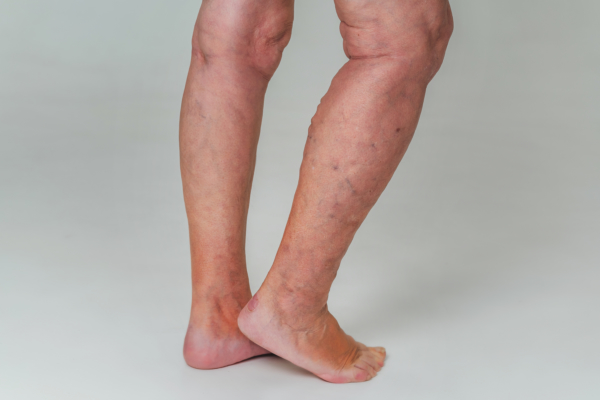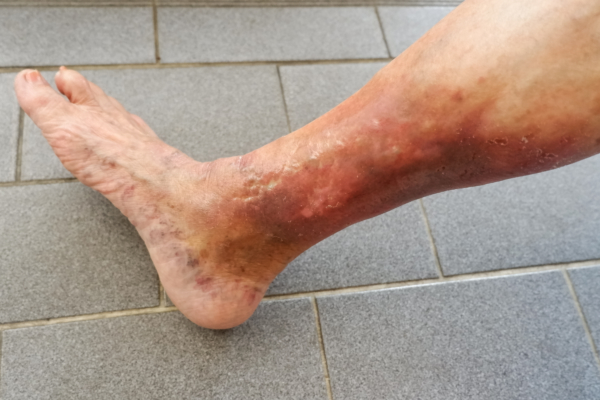What is this condition?
Varicose eczema is a skin condition. It mainly occurs in older people. It is a condition that progresses slowly, initially the skin changes colour to become pale red, and then a darker red, finally appearing to be stained brown in colour. The texture of the skin may be thicker, dry, shiny, and bumpy, or bruise easily.

What causes this?
Chronic venous insufficiency (CVI) develops over many years and occurs when the vein wall and/or valves in the veins don’t work effectively, causing blood to collect or pool in these veins. If left untreated, the pressure increases until the tiniest blood vessels in the legs (capillaries) burst, causing reddish-brown skin discoloration. This causes local tissue inflammation and damage, which is sensitive to being broken if bumped or scratched, leading to infection, known as cellulitis, or open sores on the skin surface, known as ulcers.
Symptoms:
The symptoms of CVI are very similar to varicose vein symptoms. A patient may have one or more of the following symptoms:
- Swelling of the feet, ankles, and lower legs, especially after extended periods of standing or sitting,
- Flaking, scaly, dry, shiny, and/or itchy skin,
- Discoloration in the skin – a reddish/brown,
- Leathery-looking skin around the lower leg(s),
- Leg ulcers.
Who gets varicose eczema?
It is mostly seen in people in middle-aged and older people. It is reported to affect 20% of those over 70 years. It is common also in people who have varicose veins.
- History of deep vein thrombosis in the affected limb,
- History of cellulitis in the affected limb,
- Chronic swelling of the lower limb,
- Gender. Women are more at risk than men,
- Obesity. This can put more pressure on your lower limbs,
- Varicose veins,
- Ulcers.

How is this condition diagnosed?
You will need a clinical diagnosis by a GP or specialist doctor.
Is this condition treatable?
Yes, but even with treatment, your skin may not ever look exactly as it did before this condition began.
- Firstly, your doctor may suggest an ultrasound scan of your lower limb(s) to look for an underlying cause,
- Secondly, if you have varicose veins you will be offered treatment options,
- Apply regular moisturiser throughout the day to the affected limbs. You may be prescribed a topical steroid cream,
- Compression socks or stockings to help with swelling.
- Self-help techniques. These include the following:
- Avoid prolonged standing or sitting,
- Avoid injuring skin (this could lead to an infection or ulcer),
- Raise legs when you are resting,
- Keep physically active, this helps to push blood back to your heart,
- Reduce salt intake,
- Keep hydrated.
If you or someone you know has this condition, please seek medical help. Don’t wait until it gets worse and symptoms can no longer be ignored.
If you would like to book a consultation with either Mr. JK Wicks or Dr Lupe Taumeopeau click here.
Referrals are not always necessary. Contact us today.